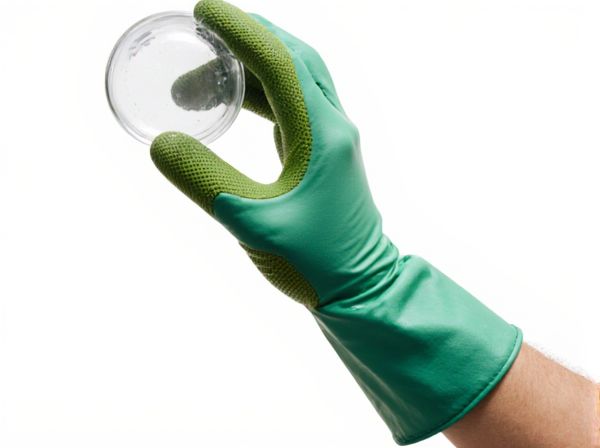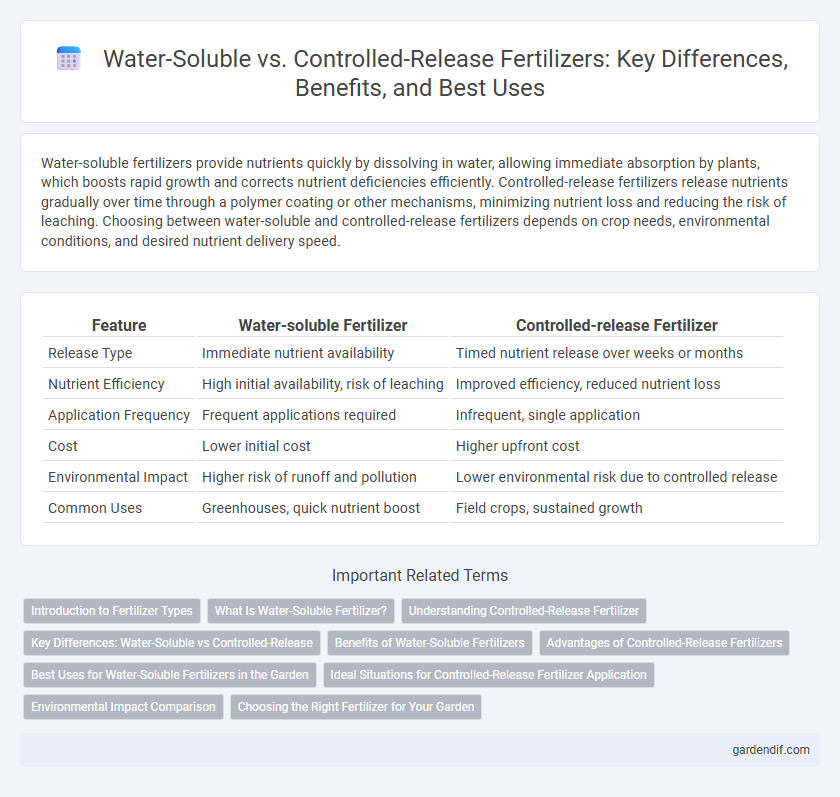
Water-soluble vs controlled-release Illustration
Water-soluble fertilizers provide nutrients quickly by dissolving in water, allowing immediate absorption by plants, which boosts rapid growth and corrects nutrient deficiencies efficiently. Controlled-release fertilizers release nutrients gradually over time through a polymer coating or other mechanisms, minimizing nutrient loss and reducing the risk of leaching. Choosing between water-soluble and controlled-release fertilizers depends on crop needs, environmental conditions, and desired nutrient delivery speed.
Table of Comparison
| Feature | Water-soluble Fertilizer | Controlled-release Fertilizer |
|---|---|---|
| Release Type | Immediate nutrient availability | Timed nutrient release over weeks or months |
| Nutrient Efficiency | High initial availability, risk of leaching | Improved efficiency, reduced nutrient loss |
| Application Frequency | Frequent applications required | Infrequent, single application |
| Cost | Lower initial cost | Higher upfront cost |
| Environmental Impact | Higher risk of runoff and pollution | Lower environmental risk due to controlled release |
| Common Uses | Greenhouses, quick nutrient boost | Field crops, sustained growth |
Introduction to Fertilizer Types
Water-soluble fertilizers dissolve quickly in water, providing immediate nutrient availability for rapid plant uptake and fast growth response. Controlled-release fertilizers release nutrients gradually over time through a polymer coating or chemical formulation, ensuring prolonged nutrient supply and reducing leaching losses. Selecting the appropriate fertilizer type depends on crop nutrient demand, soil conditions, and desired timing of nutrient delivery for optimal plant development.
What Is Water-Soluble Fertilizer?
Water-soluble fertilizer refers to nutrient formulations that readily dissolve in water, allowing plants to absorb essential elements like nitrogen, phosphorus, and potassium quickly. This type of fertilizer is often used in fertigation systems and foliar feeding to provide immediate nutrient availability and support rapid plant growth. Compared to controlled-release fertilizers, water-soluble options offer faster nutrient uptake but require more frequent applications to maintain optimal soil fertility.
Understanding Controlled-Release Fertilizer
Controlled-release fertilizers release nutrients gradually through polymer coatings or chemical reactions, optimizing nutrient availability and reducing leaching losses. These fertilizers enhance plant growth efficiency by synchronizing nutrient release with root uptake patterns. Water-soluble fertilizers, by contrast, provide immediate nutrient availability but require frequent application to maintain optimal soil nutrient levels.
Key Differences: Water-Soluble vs Controlled-Release
Water-soluble fertilizers dissolve quickly in water, providing immediate nutrient availability for rapid plant uptake, ideal for quick growth and short-term nutrient boosts. Controlled-release fertilizers release nutrients gradually over an extended period through coating membranes or chemical formulations, ensuring sustained nutrient supply and reducing leaching losses. The primary difference lies in their nutrient release rate, with water-soluble types suited for immediate nutrient needs and controlled-release designed for long-term feeding efficiency and environmental protection.
Benefits of Water-Soluble Fertilizers
Water-soluble fertilizers provide rapid nutrient availability, facilitating immediate uptake by plants and promoting faster growth. These fertilizers enhance precision in nutrient management by allowing easy adjustment of nutrient concentrations based on plant needs. Their high solubility also improves distribution uniformity in irrigation systems, optimizing nutrient efficiency and reducing waste.
Advantages of Controlled-Release Fertilizers
Controlled-release fertilizers provide a steady supply of nutrients over an extended period, enhancing nutrient use efficiency and reducing leaching losses. They minimize the risk of nutrient runoff, promoting environmental sustainability in agricultural practices. These fertilizers also reduce the frequency of application, lowering labor costs and improving crop yield consistency.
Best Uses for Water-Soluble Fertilizers in the Garden
Water-soluble fertilizers are ideal for providing rapid nutrient uptake in vegetable gardens, container plants, and hydroponic systems due to their quick dissolution and immediate availability to roots. They are best used during active growth stages to correct nutrient deficiencies and support flowering and fruiting phases. Frequent applications ensure consistent nutrient supply, making them essential for fast-growing plants requiring precise nutrient management.
Ideal Situations for Controlled-Release Fertilizer Application
Controlled-release fertilizers are ideal for crop systems requiring consistent nutrient supply over extended periods, minimizing nutrient leaching and enhancing nutrient use efficiency. They are particularly suited for long-season crops, turf grasses, and landscapes where frequent fertilizer applications are impractical. Controlled-release formulations optimize plant growth in environments with variable moisture or temperature by precisely synchronizing nutrient release with plant demand.
Environmental Impact Comparison
Water-soluble fertilizers rapidly release nutrients, increasing the risk of leaching and groundwater contamination, which contributes to environmental pollution. Controlled-release fertilizers minimize nutrient runoff by gradually supplying plants with nutrients, reducing the potential for eutrophication in aquatic ecosystems. This slow nutrient delivery enhances soil health and decreases the frequency of fertilizer applications, leading to a more sustainable agricultural practice.
Choosing the Right Fertilizer for Your Garden
Selecting the right fertilizer for your garden depends on plant type, soil condition, and growth goals. Water-soluble fertilizers provide immediate nutrient availability, ideal for rapid growth and correcting deficiencies quickly. Controlled-release fertilizers release nutrients gradually, promoting sustained feeding, reducing leaching, and minimizing environmental impact.
Water-soluble vs controlled-release Infographic

 gardendif.com
gardendif.com